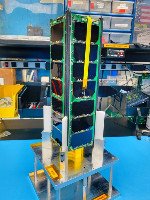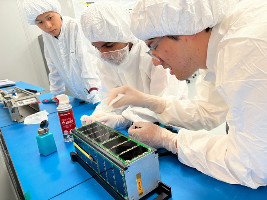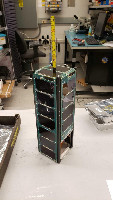| Satellite name | MARIO (Measurement of Actuator Response and Impedance on Orbit) |
|---|---|
| Form factor | CubeSat |
| Units or mass | 3U |
| Status | Reentry 2023-05-04. Was operational (Confirmation on Twitter from PE0SAT and SatNOGS last checked 2022-12-31) |
| Launched | 2022-11-26 |
| NORAD ID | 55123 |
| Deployer | NRCSD (NanoRacks CubeSat Deployer) [Quad-M] |
| Launcher | Falcon 9 (CRS-26) (ELaNa 49) |
| Deployment | Deployed from ISS on 2022-12-29 |
| Organisation | University of Michigan |
| Institution | University |
| Entity | Academic / Education |
| Headquarters | US |
| Oneliner |
Characterize the behavior and degradation of macro-fiber composite materials. |
| Description |
Characterize the behavior and degradation of macro-fiber composite materials under actuation and structural health monitoring configurations. The primary project mission is the training of next generation space and radio engineers. MARIO will provide a hands-on, inspirational opportunity for these students. As part of their training, students will integrate a technology demonstration payload into the MARIO satellite. The purpose of the MARIO science mission is to raise the technology readiness level (TRL) of macro fiber composite (MFC) piezoelectric actuators, by measuring their performance and durability in a spaceflight environment. NASA is looking for an on-orbit testbed to advance these actuators to TRL 8 so that they may be used in future space applications. The MARIO payload will provide performance and durability data for a pair of MFC actuators as part of a Beam Experiment (BE) in Low Earth Orbit (LEO). The MARIO science mission will consist of a 1U (10cm x 10cm x 10cm) payload, contained in a 3U (30cm x 10cm x 10cm) CubeSat. The satellite is being developed by Extreme Diagnostics, U-M’s Adaptive Intelligent and Multifunctional Structures (AIMS) Lab, as well as the Michigan Exploration Lab (MXL). The MARIO mission will be used for self-training of and intercommunication between student satellite operators that are also HAMs. Students will learn about space systems, electronics, link budget, RF systems, modulation, demodulation and other HAM-related topics. They will use the spacecraft test and characterize new systems for amateur satellites such as flight computers, power systems, and radios. In addition, the MARIO ground station is integrated into a larger federated ground station network, Satnogs. |
| Sources | [1] [2] |
| Photo sources | [1] [2] [3] |
| On the same launch |
Last modified: 2023-06-09



